- Sommaire----------------English
version----------------
Base
de données matières
-
-
- Autres pages sur le sujet
: le
Floating Blue
"Cendré"
--------------------Floating
Blue à cône 04
(1060°C)
-
-
-
|
LE
"FLOATING BLUE"
par
Edouard Bastarache
|
-
-
- Le
"Floating Blue" est probablement la plus connue et la
plus populaire des glaçures de cône 6.
Comme la plupart des autres émaux
glaçés contenant du Gerstley
Borate,
elle contient aussi de la Néphéline
Syénite, de la Silice et du Kaolin. Les effets
bigarrés de surface sont causés par le
Rutile au niveau d'environ 4%
- .
- Le
terme " floating " peut être dû à
deux possibilités :
-
- 1 -
La surface colorée en bleu de cobalt semble
flotter sur une couche de verre brun translucide.
Cette couche est visible lorsqu'elle devient brune par
amincissement sur les rebords de la pièce et
les irrégularités et/ou textures de
surface.
- 2 -
Plus particulièrement, cependant, ce terme
s'applique à une couche opalescente, blanche -
'bleu de bore', qui semble souvent flotter sur un fond
de bleu de cobalt. Certains auteurs disent que "les
couleurs semblent flotter à la surface d'un
fond foncé ayant une grande profondeur,
rappelant une profonde mare d'eau" .
-
-
- La
chose étonnante au sujet de ce type de
glaçure, c'est qu'elle puisse produire des
effets bigarrés de surface par six
mécanismes différents :
-
- - Sa
couleur et son opacité changent
considérablement avec l'épaisseur, ainsi
elle met en valeur les irrégularités de
surface.
- - La
"séparation de phase" dans la matrice
translucide fait tourbillonner la couleur comme de
petits ruisseaux d'un écoulement de verre plus
liquide autour de phases plus visqueuses.
- - Les
cristaux de titane dans la matrice la font
étinceler.
- - Les
cristaux de borate de calcium bleus croissent à
la surface.
- - Les
bulles de gaz qui s'échappent créent des
flaques (lacs) de verres colorés plus
légèrement, entourées par des
anneaux plus foncés.
- - De
petites taches noires sont produites par des
particules de fer non dispersées.
-
- Pas
surprenant que ce soit une glaçure si populaire
auprès des potiers.
-
-
- Tous
ceux qui ont utilisé ce type de glaçure
témoigneront du fait qu'elle est
"inconsistante" et qu'elle a tendance à couler.
- Il y
a un certain nombre de recommandations concernant son
utilisation :
- -
utiliser de l'eau distillée ou basse en
minéraux,
- -
tout tamiser à 80 mailles,
- -
bien brasser la glaçure avant et pendant son
utilisation afin d'empêcher la
précipitation du fer,
- -
appliquer l'épaisseur d'un dix sous (1mm.),
- -
cuire en oxydation à cône 6 exactement,
et refroidir normalement.
-
-
- Gerstley
Borate :
- Certaines
recettes proposées contiennent du Gerstley
Borate, une page spéciale consacrée
à cette matière typique Nord
Américaine fournit des substitutions à
base de produits disponibles en Europe (frittes et
felspaths).
- Consulter
la page sur le Gerstley Borate
-
-
- A
-Voici quelques exemples de ces glaçures de
cône 6 en oxydation :
-
-
- Floating
Blue
-
- Néphéline
Syénite 47.3
- Gerstley
Borate
27.0
- Silice
20.3
- Kaolin
5.4
- Total
100.0
-
- Rutile
4.0
- Oxyde
de Fer Rouge 2.0
- Oxyde
de Cobalt 1.0
-
- De
James Chappell
|
- Substitution
- avec
matières disponibles
- en
Europe
-
- Fritte
3110
38.00
- Fritte
2954
10.85
- Kaolin
calciné 21.00
- Kaolin
cru 5.50
- Felds
Potassique ICE10
13.00
- Dolomie
6.00
- Craie
1.00
- Silice
9.00
-
- Rutile
4.0
- Oxyde
de Fer Rouge 2.0
- Oxyde
de Cobalt 1.0
|
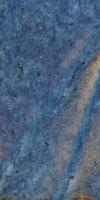
Effet "Floating
Blue" à cône 6 Orton,
oxydation
|
-
- Floating
Blue#1
-
- Néphéline
Syénite 41
- Gerstley
Borate
17
- Fritte
Ferro #3134
13
- Silice
18
- Kaolin
11
- Total
100
-
- Rutile
4
- Oxyde
de Fer Rouge 2
- Carbonate
de Cobalt 1.5
-
- De
Clayart (Ron Roy)
-
|
- Substitution
- avec
matières disponibles
- en
Europe
-
- Fritte
3110
40.00
- Fritte
2954
12.30
- Kaolin
calciné 22.00
- Kaolin
cru 5.00
- Felds
Potassique ICE10
10.00
- Dolomie
3.70
- Craie
1.20
- Silice
9.10
-
- Rutile
4.0
- Oxyde
de Fer Rouge 2.0
- Oxyde
de Cobalt 1.5
|
-
- Floating
Blue#2
-
- Néphéline
Syénite 35.5
- Gerstley
Borate
8.5
- Fritte
Ferro #3134
24.5
- Silice
16
- Kaolin
15.5
- Total
100
-
- Rutile
4
- Oxyde
de Fer Rouge 4
- Carbonate
de Cobalt 1.5
-
- De
Clayart (Ron Roy)
-
|
- Substitution
- avec
matières disponibles
- en
Europe
-
- Fritte
3110
42.5
- Fritte
2954
13.40
- Kaolin
6.00
- Kaolin
calciné 22.50
- Felds
ICE10
5.50
- Dolomie
1.80
- Craie
1.35
- Silice
9.25
-
- Rutile
4
- Oxyde
de Fer Rouge 4
- Carbonate
de Cobalt 1.5
|
- Autre
substitution
- avec
matières disponibles
- en
Europe
-
- Néphéline
syénite 30.00
- Fritte
3110
23.00
- Fritte
2954
14.30
- Felds
CR-79
2.00
- Kaolin
7.00
- Dolomie
2.00
- Craie
2.70
- Alumine
calcinée 3.30
- Silice
19.00
-
- Rutile
4
- Oxyde
de Fer Rouge 4
- Carbonate
de Cobalt 1.5
|
-
- Floating
Blue#3
-
- Néphéline
Syénite 30
- Fritte
Ferro #3134
36
- Silice
14
- Kaolin
20
- Total
100
-
- Rutile
4
- Oxyde
de Fer Rouge 2
- Carbonate
de cobalt 1.5
-
- De
Clayart (Ron Roy)
-
|
- Substitution
- avec
matières disponibles
- en
Europe
-
- Fritte
3110
40.00
- Fritte
2954
14.90
- Kaolin
5.00
- Kaolin
calciné 22.00
- Néphéline
syénite 7.00
- Craie
1.80
- Silice
11.00
-
- Rutile
4
- Oxyde
de Fer Rouge 2
- Carbonate
de cobalt 1.5
|
- Autre
substitution
- avec
matières disponibles
- en
Europe
-
- Fritte
3110
20.00
- Fritte
2954
16.00
- Kaolin
13
- Néphéline
syénite 20.50
- Felds
CR-79
20.00
- Craie
3.00
- Silice
10.70
-
- Rutile
4
- Oxyde
de Fer Rouge 2
- Carbonate
de cobalt 1.5
|
-
- B
-Un exemple pour cône 10 en oxydation
:
-
- Floating
Blue
-
- Feldspath
potassique 52.0
- Gerstley
Borate
11.5
- Wollastonite
9.0
- Kaolin
5.5
- Silice
22.0
- Total
100
-
- Rutile
4.0
- Oxyde
de Fer Rouge 2.0
- Oxyde
de Cobalt 1.0
-
- De
Clayart (Tom Buck)
-
-
- C
- Quelques exemples de cône 9-10 en
réduction :
-
-
-
-
-

|
|
- Edouard
Bastarache M.D.
- (Médecin
du Travail et de l'Environnement)
-
- Auteur de
«
Substitutions de matériaux
céramiques complexes
»
- Tracy,
Québec, CANADA
- edouardb@colba.net
|
-
-
-
-
-
- Références
:
- 1-Digitalfire.com,
Tony Hansen, Alberta, Canada
- https://digitalfire.com/
-
- e-mail
:
- thansen@digitalfire.com
- 2-The
Potter's Complete Book of Clay and Glazes, James
Chappell.
- 3-Le
newsgroup Clayart pour
céramistes.
- http://www.potters.org/categories.htm
-
-
-
- (*)
QIT-Fer et Titane, une filiale québecoise de
Rio Tinto Zinc (Angleterre), exploite une
énorme mine d'ilménite dans le nord-est
du Québec.
- Le
minérai est acheminé par bateau à
son usine de Sorel-Tracy où il est
tranformé en différents produits dont
l'ilménite et l'UGS.
- L'UGS
est un rutile synthétique granulaire et la
granulométrie que nous avons utilisée
variait de 120 à 140 mailles.
-
-
- Smart2000.fr
©
Novembre 2001
-
FRANCE
- Écrit
et documenté par le propriétaire du site
// Contact : Smart2000@wanadoo.fr
- Document
pour CONSULTATION PRIVÉE uniquement - Toute
reproduction totale ou partielle est
interdite
-
-
-
-
- Smart2000.fr
le site
dédié aux passionnés de
céramique
-
- Smart2000
- FRANCE sur https://smart2000.fr/
-
- This
entire page Copyright © 2001-2023, All Rights
Reserved.
- Les
textes et les photos restent la
propriété de leur auteurs, ils ne
peuvent être réutilisés sans un
accord préalable. Nous
consulter.
-
-
-
- Summary----------------Top
/ haut de page----------------Autre
page sur le Floating Blue
"Cendré"
-
-
- other pages
on
"wood
ash Floating
blue"
--------and-------
"cone
04 floating blue"
-
-
-
|
FLOATING
BLUE
by
Edouard Bastarache
|
-
- Floating
Blue (also called Blue Hare's Fur) is probably the
most well known and popular cone 6 pottery glaze. It
was popularized by the book The Potter's Complete Book
of Clay and Glazes by James Chappell (in the current
edition it is on page 210 under the heading "Floating
Glazes"). The author calls it "spectacular and
extraordinary". In fact, the vase that graces the
cover of the book uses this glaze. Like most other
popular glossy GB base glazes, this one also uses
nepheline syenite, silica and kaolin. Its borate
content is about middle-of-the-road compared to the
range of recipes that we have studied. Like the
Butterscotch glaze, the fired effects produced by this
recipe are a testament to the variegating effects that
4% rutile imparts to colored non-opacified boron
glazes.
-
- The
term 'floating' could refer to two possibilities in
our observation: The blue cobalt colored surface
appears to float on a translucent brown glass layer.
This layer is visible where the color breaks to
brownish hues on thinner sections at edges and
irregularities in the surface. More likely, however,
it refers to a white opalescent 'boron-blue' layer
that often appears to float over the cobalt blue
background (boron-blue calcium borate crystals form in
borate glazes when calcium is present and the glaze is
very fluid). This effect can best be amplified by
melting a ball of glaze on a tile to get a very thick
pool of glass. Cappell says "the colors seem to float
on a surface of a darker background of great depth,
reminiscent of a deep pool of water".
-
- An
amazing thing about this recipe is that it actually
has the potential to produce six separate mechanisms
of variegation:
- Its
color and opacity vary greatly with thickness so it
highlights irregularities in the surface.
- 'Phase
separation' in the translucent matrix makes the color
'swirl' as small rivulets of more fluid glass flow
around more viscous phases.
- Titanium
crystals in the matrix make it sparkle.
- Calcium-borate
boron-blue crystals grow on the surface.
- Bubbles
of escaping gases create pools of lighter colored
glass surrounded by darker rings.
- Small
black speckles are produced by unground particles of
iron.
-
- No
wonder this is such a popular glaze among potters!
-
-
- Anyone
who has used this glaze will testify to the fact that
it is "fickle" as Chappell notes. He makes a number of
recommendations on using this recipe:
- - use
distilled or low mineral water,
- -
force all material through an 80 mesh screen,
- -
stir thoroughly before and during use to prevent
settling out of the iron content,
- -
apply the thickness of a dime (1mm.),
- -
fire to cone 6 oxidation exactly, and cool normally.
-
-
- A
- Here are a few examples for cone 6 oxidation
:
-
-
- Floating
Blue
-
- Nepheline
Syenite 47.3
- Gerstley
Borate
27.0
- Silica
20.3
- Kaolin
5.4
- Totals
100.0
-
- Rutile
4.0
- Red
Iron Oxide 2.0
- Cobalt
Oxide 1.0
-
- from
James Chappell
|
 - Floating
blue / cone 6
oxidation
|
-
- Floating
Blue#1
-
- Nepheline
Syenite 41
- Gerstley
Borate
17
- Ferro
Frit #3134 13
- Silica
18
- Kaolin
11
- Totals
100
-
- Rutile
4
- Red
Iron Oxide 2
- Cobalt
Carbonate 1.5
-
- From
Clayart (Ron Roy)
-
-
- Floating
Blue#2
-
- Nepheline
Syenite 35.5
- Gerstley
Borate
8.5
- Ferro
Frit #3134 24.5
- Silica
16
- Kaolin
15.5
- Totals
100
-
- Rutile
4
- Red
Iron Oxide 4
- Cobalt
Carbonate 1.5
-
- From
Clayart (Ron Roy)
-
-
- Floating
Blue#3
-
- Nepheline
Syenite 30
- Ferro
Frit #3134 36
- Silica
14
- Kaolin
20
- Totals
100
-
- Rutile
4
- Red
Iron Oxide 2
- Cobalt
Carbonate 1.5
-
- From
Clayart (Ron Roy)
-
-
- B
-One example for cone 10 oxidation
:
-
- Floating
Blue
-
- Potassium
Spar 52.0
- Gerstley
Borate
11.5
- Wollastonite
9.0
- Kaolin
5.5
- Silica
22.0
- Totals
100
-
- Rutile
4.0
- Red
Iron Oxide 2.0
- Cobalt
Oxide 1.0
-
- From
Clayart (Tom Buck)
-
-
- C-A
few examples for cone 9-10 reduction
:
-
-
- Floating
Blue #1 C/9R
-
- Cornwall
Stone 27 (Felspath mixte)
- Potassium
Feldspar 16
- Ferro
Frit #3134
18
- Dolomite
4
- Silica
18.5
- Calcium
carbonate 6
- Ball
clay
9
- Kaolin
8
- Total
106.5
-
- Bentonite
2
- *QIT-UGS
4
- *QIT-Ilmenite
2
- Cobalt
carbonate 0.5
-
- This
is a modified version of Ron Roy's Coyote
Blue
- Published
on Clayart (newsgroup).
|
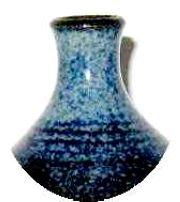 - Floating blue
#1C/9R
|
- Floating
Blue #2 C/9R
-
- Cornwall
Stone 63.8 (Feldspath mixte)
- Gerstley
Borate
14.3
- Silica
7.6
- Calcium
carbonate7.6
- Kaolin
4.8
- Zinc
oxide (calc.) 1.9
- Total
100
-
- Bentonite
2
- *QIT-UGS
4.2
- *QIT-Ilmenite
2.0
- Cobalt
carbonate 0.5
-
- This
is a modified version of Wayne Conrad's
Moonlight Blue.
- Published
on Clayart (newsgroup).
|
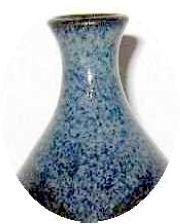 - Floating blue
#2C/9R
|
- I.
Floating Blue C/9R
-
-
- Cornwall Stone
63.8
- Gerstley
Borate
14.3
- Silica
7.6
- Calcium
carbonate 7.6
- Kaolin
4.8
- Zinc oxide
(calc.) 1.9
- 100.0
-
- Bentonite
3.0
- *QIT-UGS
5.2
- *QIT-Ilmenite
2.0
- Cobalt carbonate
1.0
|
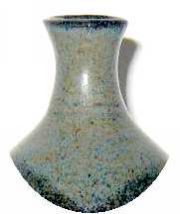 - I. Floating
blue C/9R
|
- II.
Floating Blue C/9R
-
-
- Cornwall Stone
25.2
- Custer feldspar
15.0
- Ferro
Frit
#3134
17.0
- Dolomite
3.8
- Silica
17.4
- Calcium
carbonate 5.6
- Ball Clay
8.5
- Kaolin
7.5
- 100.0
-
- Bentonite
2.0
- *QIT-UGS
4.7
- *QIT-Ilmenite
1.9
- Cobalt carbonate
0.9
|
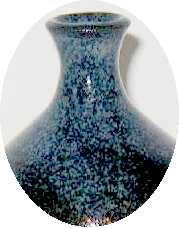 - II. Floating
blue C/9R
|
- III-Floating
Blue C/9R
-
-
- Cornwall Stone
27.0
- Custer feldspar
15.5
- Gerstley
Borate
5.0
- Ferro
Frit
#3134
13.0
- Dolomite
2.0
- Silica
12.0
- Calcium
carbonate 6.5
- Ball Clay
19.0
- 100.0
-
- *QIT-UGS
6.0
- *QIT-Ilmenite
2.0
- Cobalt carbonate
1.0
|
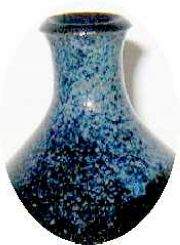 - III. Floating
blue C/9R
|
- IV-Floating
Blue C/9R
-
-
- Silica
15
- Kaolin
15
- Custer feldspar
50
- Wood ash
(washed) 20
- 100
-
- Bentonite
2.0
- Rutile
4.5
- Cobalt carbonate
4.0
|
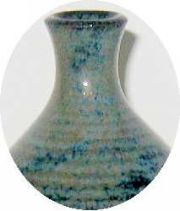 - IV. Floating
blue C/9R
|
- V-Floating
Blue C/9R
-
-
- Custer feldspar
7.7
- Cornwall Stone
44.0
- Gerstley
Borate
6.9
- Ferro
Frit
#3134
8.7
- Dolomite
1.9
- Calcium
carbonate 6.6
- Silica
12.7
- Kaolin
6.2
- Ball Clay
4.4
- Zinc oxide
(calc.) 0.9
- 100
-
- Bentonite
3.0
- *QIT-UGS
6.0
- *QIT-Ilmenite
1.9
- Cobalt carbonate
2.2
|
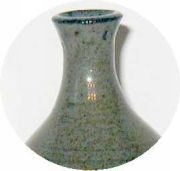 - V. Floating
blue C/9R
|
- VI.
Floating Blue C/9R
-
-
- Cornwall Stone
63.8
- Gerstley
Borate
14.3
- Silica
7.6
- Calcium
carbonate 7.6
- Kaolin
4.8
- Zinc oxide
(calc.) 1.9
- 100
-
- Bentonite
3.0
- *QIT-UGS
3.2
- *QIT-Ilmenite
2.0
- Cobalt carbonate
0.5
|
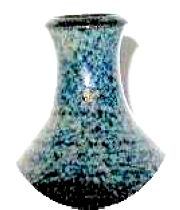 - VI. Floating
blue C/9R
|
-
-
-
-
-
-
References
:
- 1-Digitalfire.com,
Tony Hansen, Alberta, Canada
- https://digitalfire.com/
-
- e-mail
:
- thansen@digitalfire.com
- 2-The
Potter's Complete Book of Clay and Glazes, James
Chappell.
- 3-Clayart,
a newsgroup for ceramicists.
- http://www.potters.org/categories.htm
-
-
- (*)
QIT-Fer et Titane, a subsidiary of Rio Tinto Zinc
(United Kingdom),
- operates
a huge ilmenite mine in northeastern
Québec.
- The
ore is shipped to their Sorel-Tracy facilities where
it is processed to
- many
products among which ilmenite and UGS.
- UGS
is a granular synthetic rutile and the particle size
used varied
- from
from 120 to 140 mesh.
-
-
- Smart2000.fr
©
Novembre 2001
-
FRANCE
- Contact
: Smart2000@wanadoo.fr
- Document
pour CONSULTATION PRIVÉE uniquement - Toute
reproduction totale ou partielle est
interdite
-
-
-
-
- Base de
données :
Matières
-
-
- Frittes
Nord Américaines courantes
:
- (Formules de
seger)
-
- Fritte
Pemco P-25 : K2O 0,184 Na2O 0,760 CaO 0,029 ZnO 0,028
Al2O3 0,381 B2O3 0,774 SiO2 2,629
- Fritte
Pemco P-311 : K2O 0,020 Na2O 0,288 CaO 0,691 Al2O3
0,270 B2O3 0,570 SiO2 2,486
- Fritte
Pemco P-626 : BaO 0.664 Na2O 0.336 Al2O3 0.197 B2O3
.662 SiO2 3.044
- Fritte
Ferro 3110 : K2O 0,064 Na2O 0,644 CaO 0,293 Al2O3
0,095 B2O3 0,097 SiO2 3,003
- Fritte
Ferro 3124 : K2O 0,020 Na2O 0,282 CaO 0,698 Al2O3
0,269 B2O3 0,547 SiO2 2,555
- Fritte
Ferro 3134 : Na2O 0,317 CaO 0,683 B2O3 0,634 SiO2
1,476
- Fritte
Ferro 3191 : Na2O 0,501 CaO 0,499 B2O3 1,002 SiO2
2,000
- Fritte
Ferro 3195 : Na2O 0,313 CaO 0,686 Al2O3 0,404 B2O3
1,099 SiO2 2,751
- Fritte
Ferro 3211 : CaO 1,000 B2O3 1,100
- Fritte
Ferro 3230 : BaO 0,03 K2O 0,25 Na2O 0,64 ZnO 0,08 SiO2
2,26
- Fritte
Ferro 3278 : Na2O 0,669 CaO 0,331 B2O3 0,842 SiO2
2,530
- Fritte
Ferro 3289 : Na2O 0.332 BaO 0.668 Al2O3 0.198 B2O3
0.668 SiO2 3.070
- Fritte
Ferro 3304 : Na2O 0,07 PbO 0,93 Al2O3 0,15 SiO2
2,58
- Fritte
Ferro 3403 : Na2O 0.015 K2O 0.046 CaO 0.005 PbO 0.934
Al2O3 0.069 SiO2 1.438
-
- Ball
Clays Nord Américains :
- (Explications
d'Édouard Bastarache, edouardb@colba.net
)
-
- les ball clays
américains ont la formule
générale suivante :
- SiO2
59.25%
- Al2O3
36.19%
- Fe2O3
0.91%
- TiO2
1.71%
- CaO 0.23%
- MgO 0.23%
- K2O 1.03%
- Na2O
0.46%
- Point de fusion : 1710
°C
-
- Les ball clays anglais
sont un peu différents :
- 1 - Ils sont plus
plastiques
- 2 - Ils contiennent peu
de d'oxyde fer comparativement aux ball clays
américains.
- 3 - Ils contiennent par
contre de très grandes quantités de
carbone qui disparait à la
cuisson.
-
- Le point de fusion moyen
des kaolins est de 1785 °C
-
- Donc, il est vrai qu'ils
sont des argiles très plastiques mais, il
faudrait aussi dire qu'ils sont très
réfractaires.
- Ici quand on manque de
kaolin pour une glaçure, on le remplace par un
ball clay.
-
- Matières
typiques Nord Américaines
:
- (Les compositions sont
données en % massiques)
Ocmulgee
red clay : A sandy, coarse, iron-bearing clay formed
by sedimentary deposition by moving water. Composition %
0.358 Na2O 1.285 K2O 0.793 MgO 0.37 CaO 21.82 Al2O3 53.86
SiO2 1.196 TiO2 6.4 Fe2O3 0.230 MnO 8.9 Perte au
feu
Pine
lake fire clay : Composition % 0.2 Na2O 0.6 K2O 0.1
MgO 0.3 CaO 27.3 Al2O3 58.6 SiO2 1.9 TiO2 1.5 Fe2O3 9.5
Perte au feu
Goldart
stoneware : A plastic Ohio fire clay / stoneware
clay. Formed by metamorphosis of an ancient swamp.
Composition % 0.17 Na2O 1.00 K2O 0.23 MgO 0.09 CaO 28.53
Al2O3 57.46 SiO2 1.99 TiO2 1.25 Fe2O3 9.28 Perte au
feu.
Kentuky
OM#4 ball clay : OM #4 is a fine-grained ball clay
with good plasticity and strength. It is very common in
glaze recipes. It undergoes a sudden color shift around
cone 8-9, from straw yellow to solid gray [IMC].
Composition % 0.3 Na2O 1.0 K2O 0.4 MgO 0.3 CaO 27.9 Al2O3
55.2 SiO2 1.2 TiO2 1.1 Fe2O3 12.6 Perte au
feu.
Barnard
clay : A high-iron clay from glacial deposits.
Composition % 0.12 Na2O 2.04 K2O 0.75 MgO 0.27 CaO 10.87
Al2O3 59.7 SiO2 0.67 TiO2 14.65 Fe2O3 3.4 MnO 7.48
Perte au feu.
Grolleg
china clay (exception cette matière est Anglaise):
A primary (residual) kaolin formed by the action of
hydrothermal vapors on soda feldspar in granites and
pegmatites. 81% kaolinite, 15% mica, 4% feldspar and
other minerals. Manufactured by ECC International; comes
from southwest England. Plastic and white-firing, low
shrinkage, excellent hardness. Composition % 0.10 Na2O
1.90 K2O 0.10 CaO 0.30 MgO 37.00 Al2O3 48.00 SiO2 0.03
TiO2 0.70 Fe2O3 12.01 Perte au feu
A.P
green fire clay : A Missouri fire clay - a secondary
deposit of clay and sediment in deep fresh water.
Composition % 1.0 K2O 0.35 MgO 0.35 CaO 31.0 Al2O3 52.0
SiO2 1.9 TiO2 2.0 Fe2O3 11.0 Perte au feu.
Tennessee
#9 Ball Clay : Off-white, light-firing ball clay.
Contains 74% kaolinite, 17% free quartz, 5% feldspar, and
1% organic material. Composition % 0.3 Na2O 0.4 K2O 0.4
MgO 0.5 CaO 30.1 Al2O3 54.2 SiO2 1.6 TiO2 1.1 Fe2O3 11.4
Perte au feu.
Kingsley
Kaolin : A coarse white-firing kaolin. Composition %
0.11 Na2O 0.14 K2O 0.04 MgO 0.90 CaO 38.40 Al2O3 44.80
SiO2 1.64 TiO2 0.39 Fe2O3 13.60 Perte au
feu.
P.B.X
fire clay : A Missouri fire clay. Missouri fire
clays are secondary deposits of clay and sediment formed
in deep fresh waters. Composition % 0.35 MgO 0.36 CaO
38.52 Al2O3 56.63 SiO2 1.51 TiO2 1.75 Fe2O3 0.88 Perte au
feu.
Kona F4
Feldspar : Commonly used soda feldspar; used in
porcelains because of its low iron content. Composition %
6.90 Na2O 4.8 K2O 0.05 MgO 1.70 CaO 19.60 Al2O3 66.80
SiO2 0.04 Fe2O3 0.20 Perte au feu.
Albany
slip : An iron-rich clay consisting of shale, slate,
limestone, sandstone, and dolomite deposits from glacial
Lake Albany during the Wisconsin Ice Age (10-15 thousand
years ago). Contains illite, quartz, limonite, chlorite,
calcite, dolomite, and kaolinite. Composition % 0.80 Na2O
3.20 K2O 2.71 MgO 5.81 CaO 14.63 Al2O3 57.82 SiO2 0.40
TiO2 5.21 Fe2O3 9.41 Perte au
feu.
G200
Feldspar : Commonly used potash feldspar. In many
cases can be substituted for or by Custer. Composition %
3.04 Na2O 10.75 K2O 0.81 CaO 18.5 Al2O3 66.3 SiO2 0.082
Fe2O3 0.16 Perte au feu.
- Custer
Feldspar : Commonly used potash feldspar. Can be
used to substitute for Keystone, Buckingham, Yankee,
or Kingman feldspars. Composition % 2.91 Na2O 10.28
K2O 0.30 CaO 17.35 Al2O3 69.00 SiO2 0.12 Fe2O3 0.04
Perte au feu
-
- Frittes
disponibles en Europe :
- (Formules de
seger)
-
- Fritte
Johnson-Matthey 3221 : CaO 1,000 B2O3
0,980
- Fritte
Richoux P-2954 : CaO 1,000 Al2O3 0,100 B2O3 1,490 SiO2
0,610
-
- Matières
premières Européennes
:
- (Formules en %
massiques)
- (Feldspaths
Français Denain-Anzain Minéraux -
DAM)
-
- Feldspath
ICE 10B : Feldspath potassique. Composition %
67.80 SiO2 18.60 Al2O3 0.17 Fe2O3 0.10 TiO2 3.10 Na2O
10.00 K2O 0.40 CaO 0.40 Perte au feu. Analyse
minéralogique : 58.00 Orthose 26.00 Albite
11.00 Quartz 2.00 Plagioclases 1.00
Div.
-
- Feldspath
CR-79 : Feldspath Sodique. Composition % 70.50
SiO2 18.00 Al2O3 0.10 Fe2O3 0.17 TiO2 9.00 Na2O 1.00
K2O 1.00 CaO 0.23 MgO. Analyse minéralogique :
76.00 Albite 7.00 Orthose 11.00 Quartz 5.00
Plagioclases 1.00 Div.
-
-
- Smart2000.fr
©
Novembre 2001
-
FRANCE
- Contact
: Smart2000@wanadoo.fr
- Document
pour CONSULTATION PRIVÉE uniquement - Toute
reproduction totale ou partielle est
interdite
-
-
-
-
- Smart2000.fr
le site
dédié aux passionnés de
céramique
-
- Smart2000
- FRANCE sur https://smart2000.fr/
-
- This
entire page Copyright © 2001-2023, All Rights
Reserved.
- Les
textes et les photos restent la
propriété de leur auteurs, ils ne
peuvent être réutilisés sans un
accord préalable. Nous
consulter.
|









